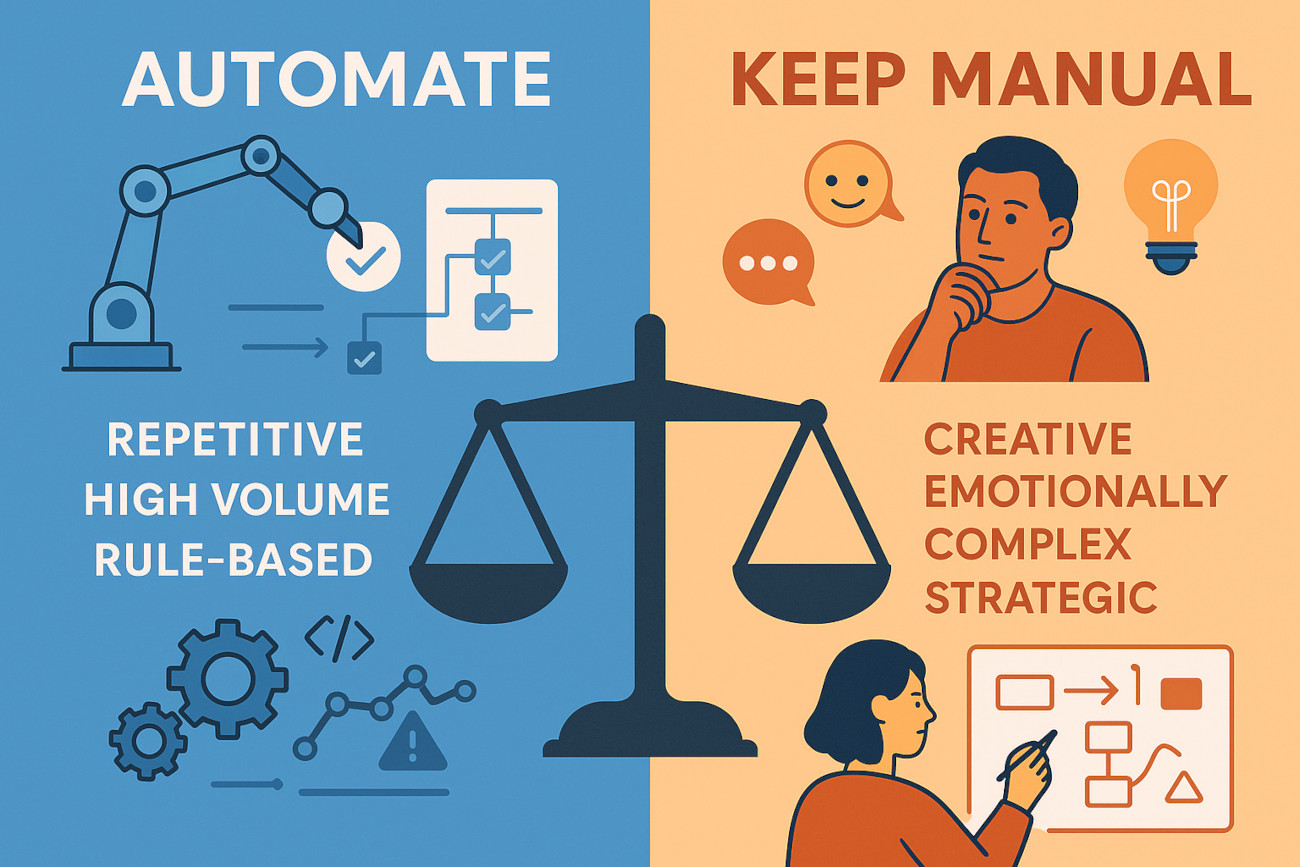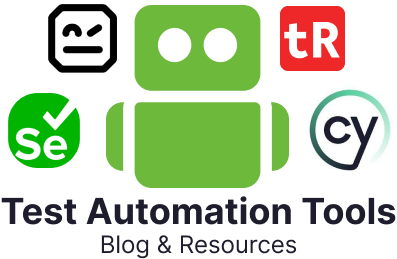Automation is an essential step to guarantee accurate software testing, IT management, and business operations as we have increasingly embraced digital transformation. However, not everything needs to be automated, even though it can boost accuracy, scalability, and speed. Organizations and teams need to be aware of what should and should not be automated to prevent over-automation, inefficiencies, or unknown risks.

The article will discuss specific guidelines to help you understand which tasks should be automated, which should remain manual, and how to strike the right balance.
Understanding the Goal of Automation
Repetitive, time-consuming, and rule-based tasks can be completed with reduced manual labor when they are automated. Automation aims to improve productivity, reduce human error, and speed up procedures in marketing campaigns, business workflows, and software testing. Automation can, however, result in brittle systems, extremely high maintenance expenses, and a loss of human judgement if it is implemented rashly.
Standards for Determining which Elements should be Automated
Prior to automating any task, evaluate each task using the following standards:
- Repetitiveness: How frequently and consistently is the task completed?
- Rule-based: Is it possible to complete the task by applying a logical, predictable set of rules?
- Volume: Is there a high volume of data or interaction included in the task?
- Impact of Errors: Do errors lead to significant system failures, or are they costly?
- ROI: Does automation cause cost or time savings that far outweigh the original structure?
- Stability: Is the procedure steady and unlikely to be modified frequently?
- Time Sensitivity: Does the task need immediate completion or prompt reaction?
To prioritize automation candidates as per the above criteria, use a decision matrix or a weighted scoring model. It is a clear guidance to proceed when a number of criteria support automation. Automation might not be the right choice, though, if even one element such as human judgement or high variability is dominating.
What to Automate?
Repetitive, High-Impact Tasks
Software Testing: Regression and Unit Tests
Automation is best suited for tasks like smoke testing, regression testing, and unit testing. To validate critical functionalities, these iterative tests must be executed frequently. Consistency, faster feedback loops, and proactive bug detection are guaranteed when they are automated.
Business Process Automation (BPA)
It is possible to automate processes such as customer support routing, employee onboarding workflows, and invoice processing efficiently. These have the benefits of speed and error reduction and are rule-driven.
Data Entry and Extraction
Robotic Process Automation (RPA) is an exceptional tool for automating iterative data handling tasks such as data transfers between systems or website scraping of structured data.
Monitoring and Alerting
Error logs, performance metrics, and system health can all be monitored by automated systems. When discrepancies arise, alerting systems can immediately alert the relevant departments.
Marketing and Sales Workflows
Email campaigns, lead nurturing, social media posting are all handled by marketing automation tools. Lead scoring and automated CRM updates are beneficial to sales teams.
What Not to Automate?
Tasks that Demand Human Intervention
Usability and Exploratory Testing
Exploratory testing calls for imagination and intuition. Likewise, evaluating the subjective and context-driven user experience is all part of the usability testing. This is fundamentally different from what automated tests validate, which is expected behavior.
Strategic Decision Making
Humans should continue to manage tasks that need vision, empathy, or nuanced judgment, such as managing team dynamics or creating a product roadmap. Ethics and critical thinking cannot be replicated by automation.
Creative Work
It demands creativity and emotional intelligence to create efficient copy, create a brand identity, or write a video script. While AI tools can help with these tasks, they shouldn’t fully replace human creators.
Customer Interactions with Emotional Nuance
FAQs and transactional communications are ideal tasks for chatbots, but escalations and intense emotional discussions require empathy and problem-solving skills that automation still falls short of.
One-off or Low-frequency Tasks
Unless their strategic value justifies automation, tasks that are done relatively rarely or that need a high setup cost for automation should be done manually.
Software Testing: To Automate or Not?
Here’s a quick overview of what types of tests one should and should not automate.
| Type of Test | Automate? | Reason |
|---|---|---|
| Unit Tests | Yes | Fast, iterative, and often executed on every code change. |
| Regression Tests | Yes | Repetitive, high-value tests that ensure existing functionality still works. |
| Smoke Tests | Yes | Basic, stable tests that validate critical functionalities quickly. |
| API Tests | Yes | Rule-based and fast, good for automation with high reliability. |
| Performance/Load Tests | Yes | Require consistency and are resource-intensive when done manually. |
| Data Validation Tests | Yes | Easily repeatable and rule-based, perfect for automation. |
| UI Tests (Basic workflows) | Yes (Partly) | Can be automated but requires stable UIs and selective coverage. |
| Exploratory Testing | No | Depends on human intuition, creativity, and domain knowledge. |
| Usability Testing | No | Requires human expertise and subjective feedback. |
| Ad-hoc Testing | No | Spontaneous and unstructured—better suited to manual testing. |
| Accessibility Testing | Mixed | Some checks can be automated; others need human intervention (e.g., screen reader tests). |
| Security Testing | Mixed | Automated tools can detect known issues; manual testing is needed for logic flaws and risks. |
Striking the Right Balance Between Manual and Automation Tasks
A well-rounded strategy steers clear of both insufficient and excessive automation. The guidelines below will help you maintain balance:
- Hybrid Models Work Best: To enhance coverage, combine automated and manual testing.
- Automate the Repetitive Tasks, Not the Unique: The manual option is more appealing if the task changes significantly from time to time.
- Start Small, Scale Wisely: Initiate automation with measurable successes and work your way up.
- Reevaluate Regularly: The tasks that were not automatable a year ago, might be feasible today. Periodic evaluations ensure alignment with changing goals and tools.
When should you opt for Business Process Automation?
Automation is especially helpful in the following situations:
- The procedure is properly established and accurately recorded.
- The number of transactions is high.
- Process errors lead to serious harm to one’s reputation or finances.
- A high amount of manual labor is needed in the process, which could be used for more critical value activities.
- The benefits of automation far exceed the expenses of upkeep and setup.
- The dependencies, steps, and outcomes are well-defined.
- Measurable Key Performance Indicators (KPIs) are available to monitor improvements.
- E-commerce order processing, financial compliance workflows, and HR employee onboarding are a few examples. Automation encourages scalability, ensures consistency, and decreases bottlenecks in each situation.
Avoid automating unclear or still-evolving processes. Automating a process that has defects only makes it more inefficient. Workflow should always be mapped and optimized before being automated.
Tools that Support Intelligent Automation
There are many different tools available, depending on the element that you are targeting:
- Testing: testRigor, Selenium, Qase.io, and Cypress.
- Business Processes: Microsoft Power Automate, UiPath, and Zapier.
- Monitoring: Prometheus, Datadog, and New Relic.
- Marketing/Sales: HubSpot, Mailchimp, and Salesforce.
Although these tools often have intelligence built into them to enhance workflows, careful configuration and maintenance are also required.
Typical Automation Pitfalls to Avoid
- Automating Too Early: Steer clear of automating a process before it has achieved a stable state.
- Ignoring Maintenance Costs: As systems evolve, automation scripts must be updated.
- Over-Automation: Automating low-frequency, complicated tasks often leads to a waste of effort.
- Absence of Human Oversight: Errors can propagate fast if automation is implemented unchecked.
- One-Size-Fits-All Mentality: Not all tasks or processes will benefit from automation in the same manner. Inefficiencies may result from using the method across functions or departments.
- Failure to Involve Stakeholder: Ignoring important nuances or automating the incorrect workflows can result from failing to include stakeholders.
- Underestimating Training Requirements: In order for teams to successfully implement and handle automation tools, they need time and direction.
A strategic, phased method to automation that includes planning, stakeholder alignment, continuous improvement, and pilot testing is necessary to prevent these pitfalls.
Conclusion
Clearly defined criteria, context, and long-term strategic objectives should all be taken into account when deciding what should and should not be automated. When used properly, automation can be a strong support, but it is not a silver bullet. When automation tools and human intelligence work together, the best results are gained.
Prioritizing automating iterative, data-driven, and time-intensive tasks while maintaining human insight for work that is creative, strategic, and emotionally complex. This balance ensures the efficiency and sustainability of your automation journey.
